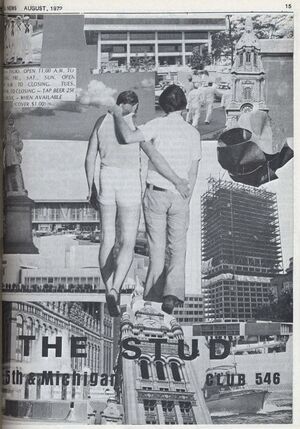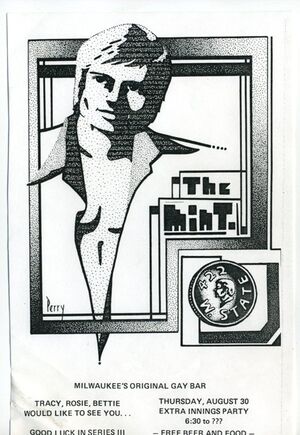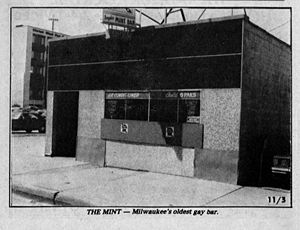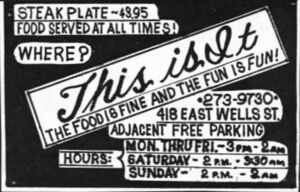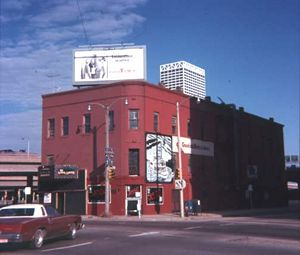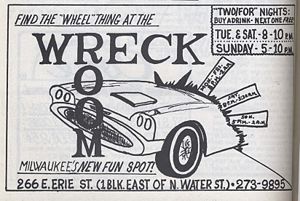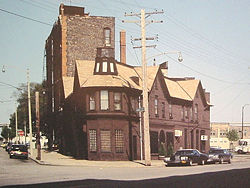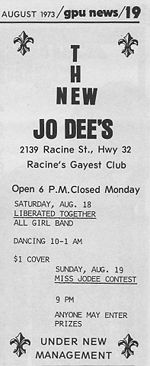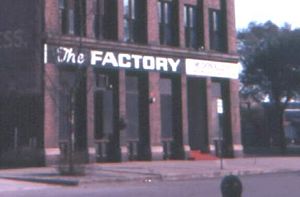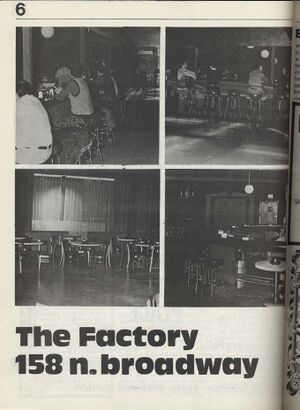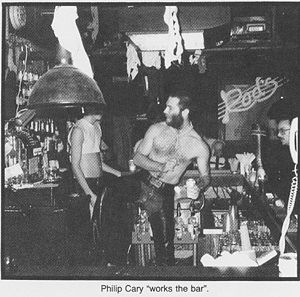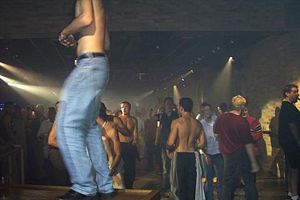Wis. LGBT History-- Businesses
BUSINESSES in Wisconsin's LGBT History
Like virtually all cities, Milwaukee, Madison and Green Bay all had "gay bars" as their first visible presence of a "gay and lesbian community". These were the early "public" gathering places to meet others, and the focal point of "gay life" to most members of the "straight" community. Over time, other types of businesses opened (bath houses, restaurants, stores and other retail establishments, etc.), but bars were the first and still most visible presence of gay life in most cities.
The Wisconsin LGBT History Project website has listings of hundreds of bars and dozens of other gay and lesbian businesses, with over 200 gay and lesbian bars documented by an individual web page with its known history, plus dozens of web pages for restaurants, bath houses, and other businesses. Explore all of these at
All of the known Gay and Lesbian bars in Wisconsin from 1969 to 2010 are listed in a sidebar: WisLGBT Sidebar: Bars in Wisconsin
Some of the more notable bars in Wisconsin's LGBT history are:
Club 546 - (Milwaukee, c1935-1973)
Club 546 was the name used for this long-time bar in its final years in existence. Located in the Royal Hotel at the corner of 5th and Michigan, the bar had long been a gay and lesbian bar, cafe, and meeting place, and continued to hold a strong clientele to its final days.
This bar was known simply as the Royal Hotel Bar when it first began to be frequented by gay people. By about the mid-1930's it was already recognized as a popular meeting place for gay people in the Milwaukee area. By the late 1960's it was operating under various names, including "The Stud", "The Stud Club", and "Club 546".
In 1971, when the GPU News began publishing its monthly GPU News, the bar was first advertised as The Stud Club with a "large dance floor". But by late 1972 is was advertised as Michelle's Club 546, sometimes mentioning both a Gallery I and Gallery II, with the former being a 24 hour Cafe with more casual sandwiches etc., and the latter being a more formal Dining Room.
The end came with news that the Royal Hotel was to be torn down to make way for a new Red Cross Insurance building. According to an article in the September 1973 issue of the GPU News, Michelle's bar would be closing its door for the last time on Sunday, September 23, 1973, after some 40 years of being a haven for gay people to meet and socialize- surely the end of an era.
Mint Bar - (Milwaukee, 1949-1990)
The Mint Bar had one of the longest histories of a gay bar in the Milwaukee area. Opening in 1949 on State Street in downtown, 20 years before Stonewall, the bar was an early beacon for gay men in Milwaukee. In 1971, when the GPU News began publishing its monthly GPU News, the bar immediately began advertising, calling itself a "male bar". It was managed for many years by Angel (Angelo Aiello), until his death in 1978, when his wife Betty Aiello took over.
The August 1976 issue of the local "GLIB Guide" describes the business as follows: "Plain. One of the oldest gay bars in the city."
Very early in 1986, the area in which the Mint was located was targetted as the site for a new Bradley Center Complex (a new sports and entertainment arena), and the Mint Bar was forced to relocate.
The Mint Bar moved to the near south side, where gay bars were becoming more common. But it survived for just another 3 years on S. 2nd Street; other bars were becoming both numerous and popular, and the historical draw of the Mint no longer held sway with younger gays and lesbians, and celebrated its 40th anniversary there in May 1989.
Shortly after celebrating its 40th anniversary, the Mint became Angelos, and then was taken over by new management which first called it BJ's Mint Bar and finally just BJ's.
This Is It - (Milwaukee, 1968-present)
This Is It was opened in 1968 by the June Brehm. Its first advertising in a gay publication doesn't appear until the August 1972 issue of the GPU News however, when its ad stated "The East Side's New Food 'N' Fun Bar" and listed proprietors Mike and June. The August 1976 issue of the local "GLIB Guide" describes the business as follows: "Popular downtown lounge busy with reserved gentlemen and then some not so reserved."
As of February, 2010, Joe Brehm, June's son, continues to operate the bar as a gay bar in relatively unaltered condition architecturally. Of course, color scheme and other changes have been made (the booths along the east wall were removed, etc.) but the bar retains it overall ambiance. While June retained ownership for over 40 years, until her death in January of 2010, her son Joe was the effective manager throughout many of those years.
Under Joe's management, the bar has the distinction of being not only one of the longest continuously running gay bar in the city, but also being a staunch supporter of the gay community by hosting countless fundraisers for the gay foundation, gay health care, charities, and other causes.
The River Queen - (Milwaukee, c1968-1980)
One of Milwaukee's most legendary gay and drag bars, The River Queen bar was one of several gay bars housed in a building originally known as the Cross Keys Hotel (built in 1853). Opened by Al Berry who had run the Rooster bar, the River Queen was rumored at the time to be backed by Chicago mob money.
The River Queen had a relatively long life, and ranged from a dance bar to a popular hang-out bar, the bar in which everyone was seen at one point or another. In its later years it was often referred to as a drag bar, although it continued to draw a mixed group. The bar is generally accepted as being frequented by "gay" national celebrities when in town for local shows or performances: these include Liberace (actually a Milwaukee-area native), Milton Berle, Paul Lynde, and others.
The last half of the 1970s sees a succession of name changes to the bar. The August 1976 issue of the local "GLIB Guide" is seemingly a last mention of the River Queen, reading: "Another familiar bar, the River Queen closed, remodeled and reopened as the Side Door. The new bar is an expanded version of the old bar, with plus carpeting and a giant-size TV screen. The Side Door also features a disco." The Side Door is named because it advertises its address as the side entrance address, 212 E. St. Paul.
But by August 1978 the River Queen is to re-open as "The S.S. River Queen", reclaiming its "402 N. Water Street" address as well. But then in May 1979 it is advertised as yet another bar, Jocks, again using the side entrance address. The struggle to remake itself ends in May 1980 when the bulding was demolished.
The Wreck Room - (Milwaukee, 1972-1994)
The Wreck Room was Milwaukee's first cowboy/ levi-leather bar. Opened July of 1972 by Wayne Bernhagen, the bar had a rustic but tasteful theme. Its first advertisement, appearing in the August 1972 issue of the GPU News, stated "Find the 'Wheel' Thing at the Wreck Room- Milwaukee's new fun spot!", and sported a drawing of the front end of a car. A visitor to the bar would find the entire front end of an actual car sticking out of one wall in the back room of the bar. The August 1976 issue of the local "GLIB Guide" describes the business as follows: "For those who think macho. Hunky numbers, lively bar, funky layout and even a T-bird's front end. Sound too good to be true? It is. Entertainment on Sunday and Tuesday."
In its heyday, the bar had three rooms plus a small outdoor patio. In addition to a large almost triangular shaped front room, there was a long and narrow back room with another bar; a small room with a store selling leather paraphanelia; and a dark and narrow outside patio used more for sex than anything else. Although the front bar was reasonably respectable most of the time, the entire back section was renowned for availability of sex, with its dark atmosphere and crowded space on Friday and Saturday nights. There are also many rumors of after-hours sex parties on the pool table and in the basement.
Over the years, the Wreck Room housed various interesting features. For a time the entire front end of a car was housed in the back room. The walls in the back room were covered with posters from other levi/leather bars around the country, and the wall nearest the pool table had several old hub caps mounted on it and was covered with a large section of chain link fence. A wooden cart with a front "yoke" carved in the shape of a large erect penis greeted visitors in the front room. (The cart was salvaged and later installed in Woody's Bar back room.
The Wreck Room was generous to its clientele. It was known to regulars for Wednesday pizza nights, where one got a ticket good for a slice of pizza with every drink. Many Sunday evenings had a variation of the then-new "Wheel of Fortune" TV game. The bar also had a variety of stage shows (bands or singing groups) as well as occasional contests. But the entire city looked forward to its legendary annual anniversary parties, when the two streets surrounding the bar were closed to traffic on a Sunday afternoon and the owner hosted a free corn roast and brat/ burger fry. (This tradition began at least by 1976: an ad for its 4th anniversary that year mentioned an outdoor party and food on Sunday Sept. 15th, and an indoor party with food on Sunday Sept. 22nd.)
Meanwhile, the owner of the bar, Wayne Bernhagen, was also extremely active outside the bar. Wayne and Tom Theis together were the force behind the Wreck Room Classic, a softball invitational tournament held every Memorial Day weekend and hosting teams from virtually every major city in the country during its heyday.
Unfortunately, the owner Wayne Bernhagen was an early victim of the AIDS epidemic, and died in 1987. Although the bar carried on after his death, it began a gradual decline, partly as a result of his loss but also because the entire bar landscape was changing. Other levi/ leather bars opened, both the popular Boot Camp (which carried on into the 2000's), and another more short-lived bar in the Sydney Hih building. But above all, the bar was being crowded out: the building that once housed the nearby Factory gay disco bar was converted to a theatre, and the industrial building right across the street from the Wreck Room was converted into MIAD, an art/ design school. Although the bar had a final large street celebration for its 21st anniversary in August-Sept. of 1993 and another more low-key celebration of its 22nd anniversary in 1994, the building was finally bought by the art/ design school MIAD and converted into a student center.
Jo'Dee's International - (Racine, 1972-present)
JoDees has been a fixture in Wisconsin's gay/lesbian bar scene for nearly as long as any other LGBT bar, open at least since 1972. It is a Racine and southeastern Wisconsin tradition as well, continuing to attract a healthy and diverse business (both gay men and lesbian women) year after year.
Advertising for Jodee's Club first appears in the February 1972 issue of the GPU News. In the August 1973 issue of GPU News, an ad appears advertising "The New Jo Dee's, Racine's Gayest Club, under new management". (Note the subtle change in spelling of the name.)
The Shack - (Kenosha, 1972-1985)
The Shack, south of Kenosha, was pretty much that: a somewhat rundown building with a low profile, tucked away on the west side of Highway 32, between Kenosha and the Illinois state line. The low whitewashed one-story building was non-descript in front, housing a dance bar area and another bar area to the rear. The bar advertised in the August 1972 issue of the GPU News that it would open on September 15 of that year, "newly remodeled, under new ownership, operated by gay management", listing Bob, Frank and Mark. At one point, future Milwaukee bar owner Al Thomas worked at the Shack.
There were some holes and odd openings in the building in later years, and one recalls it was sometimes possible to see into the rest rooms from the outside. However the bar was very popular with residents of Racine, Kenosha and towns in north-eastern Illinois (such as Zion), largely because it was somewhat out of the way and therefore anonymous to go to and park at.
In 1985, with the widening acceptance of gay bars, the owner of the Shack closed this bar and opened Club 94, right off I-94. Club 94 became wildly popular in comparison, attracting all the same people as did The Shack, but also people from Milwaukee and northern Illinois.
The Factory - (Milwaukee, 1973-1982)
The Factory is THE Legendary Milwaukee Bar- it is remembered for its large size and high ceilings, innovative decorations and schemes, and was one of the first in the Midwest with a DJ and light show (this was pre-disco!). Thus The Factory was perfectly positioned to be a smash hit when the age of disco came. It opened with 2,400 square feet of public space, and about doubled over time. Its advertising originally read "If you want to make it, make it at The Factory".
During virtually its entire run, the main room of the bar featured a huge island bar with service on all four sides. At various stages of decoration, some of the legendary designs of the Factory included:
- Tables along the sides with phones to call any other table
- A canopy over the entire island bar
- A large devil's head extending over the dance floor and containing the DJ booth, nostrils snorting smoke
- Raised dance floor made of transparent plastic, lighted from below with flashing colored lights
During a time in the mid-late 1970's, the Factory was also known as The Inferno; this was the time when a large devil's head was suspended over the dance floor. (A January 1976 ad in GPU News calls the bar "Devilishly Devine". And the August 1976 issue of the local "GLIB Guide" describes the business as follows: "Boogie down with the snorting dragon and nightly gang. Weekends offer second dance floor.")
During a good part of its run, the Factory also included a side or back room used as a beer bar and game room. An attached annex, connecting through the beer bar, was used for additional dancing and quieter visiting during busy hours, and was also used to host meetings and had a stage for performances. This was an excellent venue for drag shows as well as musical performances. The annex was also temporarily called "The Loading Dock".
For a time, the owner (Chuck Cicerello) opened a men's health club/ spa (aka bath house), the Broadway Health Club, upstairs in the same building, which was raided on numerous occasions by the then notoriously homophobic Milwaukee Police.
There was a tragedy in this bar when, in December 1980, a patron returned with a pistol after an arguement, and after ordering all patrons and employees to the floor, then shot and killed the doorman/bouncer, Dennis Wesela. (Coincidentally, a previous doorman/ bouncer of the Factory had been found murdered elsewhere in the city about a year earlier.)
Doris' Super Bar - (Appleton, 1974-1977)
Doris' Super Bar was founded as a "straight" bar, but was popular with gays and lesbians. At the time, there was no gay/ lesbian bar in the Fox Valley area.
In October of 1974, a group of members of the Fox Valley Gay Alliance (FVGA) walked into Doris’ Super Bar; they were lookming for a gay-friendly bar that might consider "going gay". Following a few discussions with owner, Doris, she was willing to give it a try, and Doris’ became a very profitable gay/lesbian bar. It appeared in the August 1976 GLIB guide as well as Bob Damron national guides for 1977 and 1978. Many FVGA meetings and parties were held at this establishment.
Sometime in 1976, the bar was sold to a gay couple and renamed the Lambda Lounge
Rod's - (Madison, 1979-1996)
After running another gay bar in Madison from 1972 to 1978 (The Back Door), entrepreneur Rodney Scheel open "Rod's" bar in the lower level (basement) of the Hotel Washington building just west of downtown Madison in 1979.
The bar had a decidedly leather/levi type ambiance. Early on, "Rod's" took on a "tradition" of the bartenders holding surprise "spot checks" for men wearing underwear- which, if found, were promptly removed (cut off) and hung over the pipes on the ceiling of the bar. In no time the pipes running in the main bar room were draped with countless cut-off underwear. The bar became an extremely popular destination for men throughout Wisconsin and even from northern Illinois.
Rod's bar became a gay icon and legend among gay men in the 1980's and 1990's Madison. Over time, the bar opened additional rooms in the back, one of which showed adult male (i.e. gay porn) videos. (On the seedier side, Rod's "men's room" had its own little tradition: on occasion one might find, along the walls holding the urinals, someone kneeling: aficionados of "water sports" were to be found that night!)
An outdoor patio was a very popular addition. Opened outside/ upstairs, the patio was popular spring, summer and fall evenings and nights, but especially weekends; a popular Sunday afternoon beer bust and cookout became another tradition. The patio also became "the place to be" the Saturday evening and night of the annual Pride celebration in Madison. After a day of fun at the MAGIC picnic in Brittany Park, Rod's would be hopping later, with people relaxing with drinks around the patio. Toward evening revelers would begin dancing, and at nightfall a spectacular laser light show would excite dancers and onlookers alike.
Through it all, Rodney and his staff had a knack for coming up with new and unique events and bar specials, which other bars could never seem to match.
The final chapter was to take place on the cold morning of Sunday, February 18, 1996. A fire was somehow sparked in the Hotel Washington, which still housed the wildly popular Rod's, plus another gay bar/ dance club (The New Bar) and a gay/lesbian restaurant (Cafe Palms). In the bitter cold, the fire department called several alarms, but to no avail-- by morning the remains of the complex were a few badly charred and leaning walls, somehow with a pride flag still flying. Although there was talk of rebuilding, that was not to be, and Rod's named legacy came to an end.
La Cage - (Milwaukee, 1984-present)
La Cage Aux Folles began as a dance bar, and was relatively popular from day 1. Upon its opening, it is also believed to be the first bar with windows open to the street (closely followed by the M&M Club, which opened theirs within a month or two). Although the dance area was not large, the location and timing was excellent, and La Cage quickly took dominance of the gay dance scene, largely helped by DJ Tony Aiello, who presided as DJ at La Cage for almost 20 years. La Cage quickly overtook Club 219 as the city's premier gay dance bar, and over the next few years competing venues such as Factory II closed; and it kept a good and loyal share of the dance crowd market as dance venues such as Kisses, Factory III, and others came and went.
Over the years, La Cage evolved. In 1988 the area of the building to the south of the La Cage bar opened as the separate but connected "Dance, Dance, Dance". About the same time, as separate area called Jazz was opened, advertised as "A not so loud adult retreat", featuring fine wine and champagne by the glass, ice cream and blended drinks, and other special touches. La Cage was also known as the bar that never stayed the same. The owner was never satisfied, and it seemed every year or two the bar underwent a drastic remodeling: bars would be ripped out and pop up against another wall, the dance floor would move and shift, the DJ booth would be remodeled, video screens came and went, etc.
The building became a small complex, with varying degrees of success. An outdoor patio was somewhat popular, but the limited summer season, and the bar's main draw as a dance bar, caused the patio to quitely go away after a season or two. A basement restaurant in the mid-1990's was never too successful, although it did offer something of a refuge from the louder music above, and there was regular traffic between the two floors. The basement eventually closed. A bar/restaurant in the basement was resurrected in 2003, named "etc", but again it had limited success, and mid-2004 held rumors of a layoff or cutback of staff.
On November 1, 2005, after nearly 20 years, the bar saw a change of ownership: original owners George and Corey sold the bar and retired to sunny Florida. New owners Michael and Kris took over the reins and re-adopted the old "La Cage" name. Under their helm, there was much less controversy and fewer rumors. What didn't change was the bar's popularity: it's dance music, location, and community involvement caused it to remain the most popular bar in the city, especially among the younger dance crowd.
On March 20, 2009, the bar hit its 25th anniversary, and celebrated in grand fashion with a special party on Friday, April 24th, 2009, at which copies of advertising from the previous 25 years were displayed. And after countless rumors over the years, the second floor was under construction, due to open as a new dance and show place (probably to open about July 2009). It seems clear that La Cage will continue to be at the center of gay bar activity in Milwaukee for some time to come.
Links
- Known GLBT Bars in Wisconsin, 1969-2010 WisLGBT Sidebar: Bars in Wisconsin
- Return to INTRO page: Wisconsin LGBT History Project- Intro
Explore the full web site documenting GLBT life in Milwaukee, Madison, Green Bay, and all of Wisconsin at: http://www.WisconsinGayHistory.org
Source: All contents of this page copyrighted by Don Schwamb of the Wisconsin LGBT History Project.
